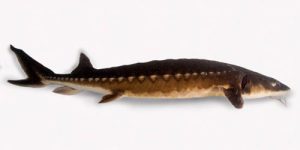The population of endangered shortnose sturgeon in the Hudson River to be nearly 70,000 individuals, according to the New York State Department of Environmental Conservation (DEC).
The research suggests that the Hudson River may contain the largest population of shortnose sturgeon anywhere in the world.
The study was coauthored by the U.S. Geological Survey (USGS) Eastern Ecological Science Center (EESC).
“The discovery of this massive sturgeon population in the Hudson River demonstrates the value of DEC’s Hudson and Delaware Marine Fisheries management of the migratory and resident fishes of the Hudson River estuary through numerous long-term monitoring surveys since the 1980s and highlights the success of the State’s ongoing efforts to restore species like the shortnose sturgeon” said DEC Commissioner Amanda Lefton.
The shortnose sturgeon was once abundant in rivers along the Atlantic coast. However, their numbers declined dramatically as the result of overfishing and habitat degradation, leading to their listing under the federal Endangered Species Act in 1973. During this period, the population in the Hudson was estimated to be only about 6,000 adults.
“This study shows that prohibitions on harvest and other protective measures enacted to support population recovery and substantial investments were successful to improve the health of the Hudson River ecosystem,” said DEC Division of Marine Resources Director Martin Gary.
In spring 2021, DEC’s Hudson and Delaware Marine Fisheries, in partnership with USGS EEC, Cornell University, University of Delaware, and Delaware State University, embarked on a large-scale project to update estimates for the Hudson’s shortnose sturgeon population using acoustic telemetry and side-scan sonar.
Acoustic telemetry uses stationary receivers to detect signals emitted from tagged marine species such as sturgeon. Side-scan sonar uses sound waves to create an image of the river floor and objects in the water column. The researchers use telemetry in tandem with side-scan sonar to locate and count fish.
With funding provided by the Hudson River Foundation, a collaborative team was assembled to assess the status of the river’s shortnose sturgeon population for the first time in three decades, a daunting task for fishes that roam throughout more than 150 miles of the tidal river.
To address this challenge, the team developed a new statistical tool that combines data from side-scan sonar surveys, processed using artificial intelligence, with telemetry.
Despite the encouraging population estimate, the study also raises concerns about the sturgeons’ vulnerability to localized disturbances. More than 40 percent of the population congregates in a small overwintering habitat, which coincides with an area of high human activity, including commercial shipping and underwater construction. This finding underscores the vulnerability of the population, despite its numerical abundance.
The study was conducted in partnership with Cornell University, University of Delaware, Delaware State University, and DEC with funding from the Hudson River Foundation and DEC’s Hudson River Estuary Management Program through New York State’s Environmental Protection Fund.
All shortnose sturgeon were collected and tagged under a National Marine Fisheries Service Endangered Species Act Research permit # 20340.
More information about shortnose sturgeon research can be found on the NOAA website or USGS Eastern Ecological Science Center website.
source: New York State Department of Environmental Conservation
